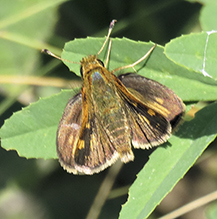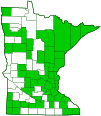Peck’s skipper
(Polites peckius)
Conservation • Description • Habitat • Ecology • Distribution • Taxonomy
|
|
||||||||||||||
Description |
Peck’s skipper is a small to medium-sized, very common, grass skipper. It is 1″ to 1¼″ in length and has a wingspan of ¾″ to 1¼″. Females are slightly larger than males. The wings are proportionately short and broadly triangular. The hindwing is distinctly rounded. The upperside of the hindwing is brown with a large, central, orange patch. The patch is broken by dark veins and appears as four or five postmedian spots. The underside is brown with a band of large orange spots at the base and a band of six large orange spots near the middle of the wing. The third spot from the outer margin is distinctly longer than the rest. This character is sometimes referred to with the mnemonic “Peck’s is a Pointer”, and can also be seen on the upperside. The basal and median spots are usually separated by dark veins. Occasionally, the bands run together and the veins between the spots are the same color as the spots. On these individuals, the wing underside appears mostly orange. The upperside of the forewing is brown with an irregular row of orange rectangular spots: three small spots near the margin in the in the postmedial area, then two smaller spots in the subapical area, then three larger spots extending to the inner margin in the medial area. On the male, there is also a prominent, black, sinuous stigma, and an orange area between the stigma and the leading edge of the wing (costal margin). The underside is similarly colored. The female is darker and lacks the stigma. The antennae are short and faintly striped. Each antenna has a black swelling (club) at the tip, and a pale, thin, hooked extension (apiculus) at the end of the club. The caterpillar is about ¾″ long and dirty brown with tiny pale spots. The thorax and abdomen are densely covered with moderately short hairs and have a dark stripe running down the middle. The breathing pore (spiracle) on the eighth abdominal segment is conspicuously enlarged. The head is very dark with a pair of indistinct white lines down the middle, and a short white bar between the eyes and between the mandibles. Behind the head there is a distinct black collar with a white front (anterior) margin. The preceding description could easily be made for all other Polites caterpillars. Long dash (P. mystic) has somewhat shorter hairs, crossline skipper (P. origenes) has very short hairs, and tawny-edged skipper (P. themistocles) has hairs so short that the caterpillar may appear glossy. Identification is best made by rearing them into adults. Mature caterpillars are seen from early spring to late fall. |
Size |
Total length: 1″ to 1¼″ Wingspan: ¾″ to 1¼″ |
Similar Species |
Long dash (Polites mystic) wing undersides are orangish-brown and less contrasting. The hindwing underside lacks the conspicuously long median spot. The orange spots on the upperside appear as more of a band than a “patch”. Tawny-edged skipper (Polites themistocles) wings are darker. The hindwing lacks the orange patch. |
Habitat |
Meadows, forest clearings, marshes, pastures, old fields, powerline right-of-ways, suburbs, and other open grassy areas near wetland edges. |
Ecology |
Season |
Probably two broods in Minnesota: Late May through June and mid-August to late September |
Behavior |
Like all skippers, they have a rapid, darting flight. They tend to stay close to the ground. |
Life Cycle |
Males perch on low vegetation throughout the day waiting for passing females. The female lays pale green eggs singly on the foliage of host plants. Larvae make a shelter by rolling one leaf or tying adjacent leaves together with silk. They live in their shelters, exiting only at night to feed. Second brood larvae overwinter in their shelters as third, fourth, or fifth instar caterpillars and pupate in their shelters in the spring. |
Larva Hosts |
Rice cutgrass, and probably bluegrass, brome, and other grasses. |
Adult Food |
Flower nectar from a wide variety of species |
Distribution |
||
|
Sources 21, 24, 27, 29, 30, 71, 75, 82, 83. Biodiversity occurrence data published by: Minnesota Biodiversity Atlas (accessed through the Minnesota Biodiversity Atlas Portal, bellatlas.umn.edu, 7/22/2025). |
|
| 7/22/2025 | ||
Occurrence |
||
Very common |
||
Taxonomy |
|
Order |
|
Superfamily |
Papilionoidea (Butterflies) |
Family |
Hesperiidae (Skippers) |
Subfamily |
Hesperiinae (Grass Skippers) |
Tribe |
Hesperiini |
Suntribe |
Hesperiina (Branded Grass Skippers) |
Genus |
Polites |
Subgenus |
Polites |
|
|
Skippers have traditionally been placed in their own superfamily Hesperioidea because of their morphological similarity. Recent phylogenetic analysis (Kawahara and Breinholt [2014]) suggests that they share the same common ancestor as other butterfly families, and thus belong in the superfamily, Papilionoidea. |
|
Subordinate Taxa |
|
|
|
Synonyms |
|
Hesperia peckius Hesperia wamsutta Papilio cora Polites coras |
|
Common Names |
|
Peck’s skipper yellow patch skipper yellow spot skipper yellow spotted skipper yellowpatch skipper |
|
Glossary
Apiculus
A thin hooked or pointed extension at the ends of each antennae just beyond the club of all skippers except skipperlings (subfamily Heteropterinae).
Costal margin
The leading edge of the forewing of insects.
Instar
The developmental stage of arthropods between each molt; in insects, the developmental stage of the larvae or nymph.
Spiracle
A small opening on the surface of an insect or arachnid through which it breathes.
Stigma
In plants, the portion of the female part of the flower that is receptive to pollen. In Lepidoptera, an area of specialized scent scales on the forewing of some skippers, hairstreaks, and moths. In other insects, a thickened, dark, or opaque cell on the leading edge of the wing.
Visitor Photos |
||
Share your photo of this insect. |
||
This button not working for you? |
||
Dan W. Andree |
 |
Some kind of Skipper |
Scott Leddy |
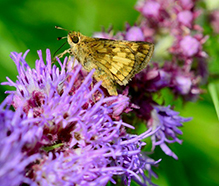 |
Alfredo Colon |
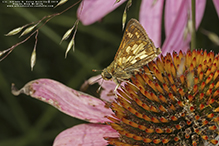 |
John Shier |
||
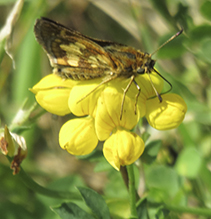 |
||
This could be usefully added to the current pix as it shows the wing underside, unlike the present 2 pix. |
This pic was taken ... at the top of Barn Bluff (Red Wing). It illustrates some of the problems of identification for skippers. |
|
Margot Avey |
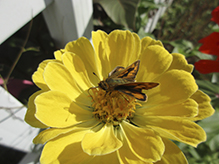 |
Took it in my back yard St Louis Park, MN today. Looks like it has double wings! |
MinnesotaSeasons.com Photos |
||
|
||
|
||

Visitor Videos |
||
Share your video of this insect. |
||
This button not working for you? |
||
|
Other Videos |
||
Peck's Skipper Butterfly |
About
Published on Sep 13, 2016 This Peck’s Skipper hangs out at our Hendricks County, Indiana, home. Please check out my other channel, kmarkdaniel, at https://www.youtube.com/channel/UCenz4XGBX4UJWOBcsBa5iOA. It has videos of trains and interesting things. |
Peck's Skipper on Strawbery Leaf - May 29, 2015 |
About
Published on Jun 1, 2015 Peck's Skipper (Polites peckius), Perched on Strawberry Leaf, Gagnon Wildlife Habitat, Somerset, Friday afternoon, Massachusetts, May 29, 2015, 1:46 PM - Panasonic Lumix DMC-FZ70 P1540748; 7.5 x 10 in. (180 dpi); 46 sec. |
Peck's Skipper (Polites peckius) Top View Working |
About
Published on Mar 9, 2017 Peck's Skipper (Polites peckius) Top View Working Video 30 sec long 34% Speed - Audio Cabarrus County, North Carolina Photo Walk - 09-28-2016 |
Peck's Skipper in Strawberry Patch - July 30, 2015 |
About
Published on Jul 30, 2015 Peck's Skipper (Polites peckius), Strawberry Patch, Gagnon Wildlife Habitat, Somerset, Massachusetts, Thursday afternoon, July 30, 2015, 3:12 PM / 3:13 PM / 3:16 PM / 3:20 PM / 3:21 PM - Panasonic Lumix DMC-FZ70 02732 / 02733 / 02734 / 02735 / 02736; 1:44 min. |
Peck's Skipper nectaring Verbena - August 9, 2014 |
About
Published on Aug 9, 2014 Peck's Skipper (Polites peckius), Nectaring Purpletop Vervain (Verbena bonariensis), near Water Garden, Gagnon Wildlife Habitat, Somerset, Massachusetts, Saturday midday, August 9, 2014, 12:10 PM - Panasonic Lumix DMC-FZ70 00418; 39 sec. |

Visitor Sightings |
||
Report a sighting of this insect. |
||
This button not working for you? |
||
Dan W. Andree |
Location: Twin Valley Prairie SNA |
 |
| Alfredo Colon 9/29/2019 |
Location: Woodbury, Minnesota |
| John Shier 8/10/2018 |
Location: Lebanon Hills Regional Park in Eagan This could be usefully added to the current pix as it shows the wing underside, unlike the present 2 pix. |
| Margot Avey 9/29/2017 |
Location: St. Louis Park, MN Took it in my back yard St Louis Park, MN today. Looks like it has double wings! |
| John Shier 8/4/2017 |
Location: at the top of Barn Bluff (Red Wing) It illustrates some of the problems of identification for skippers. The season of the year is about right for Pecks. |
MinnesotaSeasons.com Sightings |
||
|

Created: 8/6/2017 Last Updated: © MinnesotaSeasons.com. All rights reserved. |
